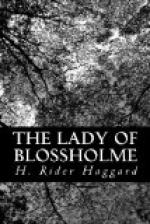Now the Bishop asked whether these women had been put to the question, and when he was told No, said that it seemed a pity, as evidently they were stubborn witches, and some discipline of the sort might have saved trouble. Again he asked if the witch’s marks had been found on them—that is, the spot where the devil had sealed their bodies, on which, as was well known, his chosen could feel no pain. He even suggested that the trial should be adjourned until they had been pricked all over with a nail to find this spot, but ultimately gave up the point to save time.
A last question was raised by the beetle-browed Prior, who submitted that the infant ought also to be accused, since he, too, was said to have consorted with the devil, having, according to the story, been rescued from death by him and afterwards been carried in his arms and given to the nun Bridget, which was the only evidence against the said Bridget. If she was guilty, why, then, was the infant innocent? Ought not they to burn together, since a babe that had been nursed by the Evil One was obviously damned?
The legal-minded Bishop found this argument interesting, but ultimately decided that it was safer to overrule it on account of the tender age of the criminal. He added that it did not matter, since doubtless the foul fiend would claim his own ere long.
Lastly, before the witnesses were called, Emlyn asked for an advocate to defend them, but the Bishop replied, with a chuckle, that it was quite unnecessary, since already they had the best of all advocates—Satan himself.
“True, my Lord,” said Cicely, looking up, “we have the best of all advocates, only you have mis-named him. The God of the innocent is our advocate, and in Him I trust.”
“Blaspheme not, Sorceress,” shouted the old man; and the evidence commenced.
To follow it in detail is not necessary, and, indeed, would be long, for it took many hours. First of all Emlyn’s early life was set out, much being made of the fact that her mother was a gypsy who had committed suicide and that her father had fallen under the ban of the Inquisition, an heretical work of his having been publicly burned. Then the Abbot himself gave evidence, since, where the charge was sorcery, no one seemed to think it strange that the same man should both act as judge and be the principal witness for the prosecution. He told of Cicely’s wild words after the burning of Cranwell Towers, from which burning she and her familiar, Emlyn, had evidently escaped by magic, without the aid of which it was plain they could not have lived. He told of Emlyn’s threats to him after she had looked into the bowl of water; of all the dreadful things that had been seen and done at Blossholme, which no doubt these witches had brought about—here he was right—though how he knew not. He told of the death of the midwife and of the appearance which she presented afterwards—a tale that caused his audience to shudder; and, lastly, he told of the vision of the ghost of Sir John Foterell holding converse with the two accused in the chapel of the Nunnery, and its vanishing away.




